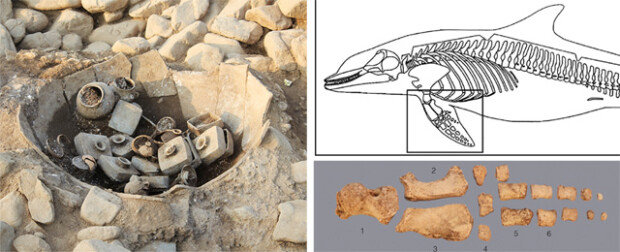Silla’s royalty uses dolphin meat for ancestral rites
Silla’s royalty uses dolphin meat for ancestral rites
Posted September. 08, 2020 07:52,
Updated September. 08, 2020 07:52

The types of food used by Silla’s royalty for ancestral rites about 1,500 years ago have been revealed for the first time. From clams and fish to sea urchins, blowfish, which is tricky to handle, and dolphins were used for their memorial ceremonies.
The National Museum of Korea published a report on Monday with new findings from the re-excavation of Seobongchong in Gyeongju, North Gyeongsang Province conducted from 2016 to 2017. The ancient tombs were originally excavated during the period of Japanese colonial rule. According to the report, the re-excavation of Seobongchong revealed the signs of ancestral rites in which large pots were placed near the stones surrounding the tomb to offer food to the owner of the tomb.
A total of 27 pots for ancestral rites were found, including 10 in the northern tumulus, 13 in the southern tumulus, and four whose locations cannot be distinguished. About 7,700 animal remains were found inside the pots, including 1,883 clams and 5,700 fish.
What’s noticeable is that the remains include those of dolphin, freshwater tortoise, and sea urchin. The remains of blowfish, whose neurotoxin must be removed for human consumption, was also discovered. Such a practice for ancestral rites had not been revealed in the excavation during the Japanese colonial era nor in the historical records, such as the Samguk Sagi or the Samguk Yusa. Given the discovery of the Pacific herring and the Japanese amberjack, the southern tomb of Seobongchong is likely to have been completed in fall.
“The animal remains discovered through the recent excavation reveal facts about not only the ancestral rites in Silla but also the eating habits of the times,” said art and science researcher Kim Dae-hwan of the archaeological history department of the museum.
Seobongchong is one of the tombs of Silla’s royalty located in the Daereungwon Royal Tomb Park in Gyeongju, which is composed of two tumuli built 500 A.D. The northern tumulus was first excavated in 1926 and the southern tumulus was discovered in 1929.
A number of golden jewelry, including a golden crown, and tomb furnishings were found in Seobongchong. However, the Japanese excavation team did not publish a report. The National Museum of Korea published a report on unearthed articles of Seobongchong in 2014, followed by re-excavation in 2016 and 2017, which revealed that the diameter of the northern tumulus was 46.7 meters, rather than 36.3 meters as examined by the Japanese group.
Min Kim kimmin@donga.com







